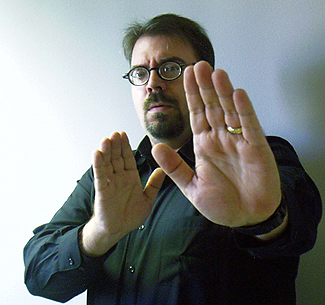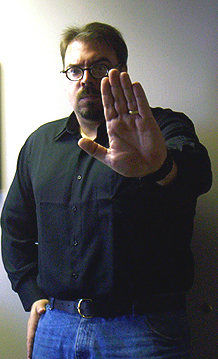its paid sponsors, whose products you need!
“Stay ‘unreasonable.’ If you
don’t like the solutions [available to you], come up with your
own.”
Dan Webre
The Martialist does not
constitute legal advice. It is for ENTERTAINMENT
PURPOSES ONLY.
Copyright © 2003-2004 Phil Elmore, all rights
reserved.
Three Criticisms and Defenses of Hands-Up Ready Stances
By Phil Elmore
 At
At
The Martialist I have written more than once about the utility of
hands-up ready stances for maintaining
space. These are as much a modification of the
double wu sao guard of Wing Chun
as they are the legacy of various Reality Based Self Defense and combatives
instructors. The point of any “fence” or “de-escalation stance,” as of
any other hands-up guard or warding posture, is to place the arms between you
and a potential threat. This creates a physical barrier while asserting
personal space boundaries.
Since I
started advocating this method for dealing with being accosted, I’ve seen
three major criticisms of hands-up ready stances. These criticisms raise
issues worth addressing.
Hands-Up
Stances Are Too Hostile
Many critics
see placing your hands up in front of your body to be very aggressive body
language that can escalate an altercation because it appears threatening.
While it’s true that assuming a double wu sao or flaring your fingers in tiger
claws might look like the prelude to a duel, the appropriate posture for
maintaining space is much less hostile. With the hands up, palms out,
combined with appropriate verbalization (“Who, there, friend, nobody wants any
trouble, let’s not crowd each other…”) the combative nature of the stance is
mitigated.
Of course, any time you put
your hands up, you are being combative to a point. You’re
asserting your personal space and you’re essentially demanding that
this be respected. Getting your hands up will always be more aggressive
than passively allowing someone to encroach on your space. Yes, when you
do this you run the risk of escalating an encounter, but that is the risk you
run whenever you resist the will, the demands, or the approach of
another person. That is what we train to do to resist the use
of force or the threat of force against us.
There will be those critics who say you should be ready to
defend yourself from any position and with appropriate maneuvering of your
body. Well, of course you should do this. Given the luxury
of preparing for a potential threat you have identified, however, why would
you not get your hands up? If action beats reaction, the man in a
hands-up ready stance will always have a slight edge over the man whose arms
hang by his sides. Given the option, getting your hands up
provides a better shield than does waiting to put those hands up after an
attack is initiated. Hands-up stances also provide an important visual
cue for maintaining personal space a cue that just isn’t as forceful when
trying to maintain space with your hands down or through body movement alone.
Hands-Up Stances Constrict Your Focus
 Some
Some
critics complain that a “fence” stance inappropriately focuses you on one
person, prompting you to ignore or neglect potential threats from elsewhere in
your environment. While this is always a possibility if one is not
mentally aware, it need not be a byproduct of such a stance. You don’t
need to turn your brain off or stop scanning the area with your peripheral
vision simply because your arms are raised.
Even when dealing with a multiple attacker scenario, the
greatest threat is presented by the person closest to you. Of course
you should focus on that person, at least initially. Just how many ninja
are hiding in the neighboring shrubbery is not your foremost concern.
You must deal with the more immediate threat.
Let’s be clear about this, however. We’re not talking
about focusing on the immediate threat to exclusion. You must
remain aware at all times, even when dealing with someone physically.
(That’s one of the reasons you must deal with a physical attack quickly and
ruthlessly because the person attacking you might not be alone. “He
may have friends” is one of those phrases my
Wing Chun
instructor uses a lot. His point is obvious. This does not,
however, invalidate the utility of the hands-up ready stance.)
Hands-Up Stances Are Vulnerable to Grabs and Breaks
This is the complaint that always kind of irritates me because
it speaks to mild ignorance on the part of the critics. I don’t mean,
though, that they must be “ignorant” if they worry about having a finger
broken or a hand grabbed, because these are valid concerns. Rather,
they’re ignorant of the way such hands-up stances are used.
Hands-up stances are dynamic, not static. If
you’re standing there like a potted plant with your arms extended and
unmoving, you deserve to have your fingers broken. The whole
point of placing your arms in front of your body is to facilitate action and
reaction. The second your would-be attacker gets close enough to grab
you, you should be doing something (in my Wing Chun school, the catch phrase
is, “He’s too close, get him!”). If he reaches for your hand or arm,
that hand or arm should be moving, countering, hitting, or whatever you’re
inclined to do. It shouldn’t be just hanging there.
When I first started Wing Chun and applied the double wu sao
guard in a sparring session with another teacher (who is not a Wing Chun
practitioner), he grabbed my wrists and applied a crossing joint lock. I
was ignorant of how to apply what I’d just learned at that early stage.
I let him get too close and I left my arms there rigidly in position without
shifting my stance.
Get Your Hands Up
A hands-up ready stance is a
dynamic, fluid means of maintaining personal space while creating a physical
barrier that improves your chances of defending against an assault. It
is assertive, though it can be assertive without appearing actively hostile.
It is not the magic solution to all self-defense scenarios.
Such postures are useful tools that, when applied with proper
awareness and mobility, increase the odds in your favor.
Get your hands up and maintain space.
